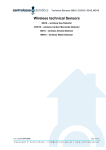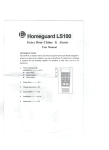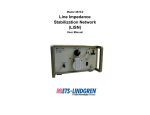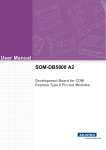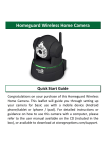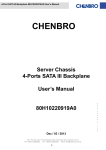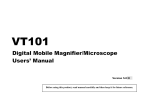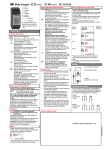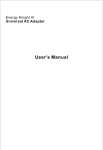Download Gas, Smoke, Co and Water Detectors
Transcript
Gas, Smoke, Co and Water Detectors 1. USER GUIDE GAS DETECTOR Installation Instructions Recommended Installation Locations Mount the detector on the wall or cabinet about 30cm above the ground for LPG or, about 30cm below the ceiling for carbon monoxide gas and natural gas use. The ventilation hole should be installed facing downwards. General limitations Install the detector securely to avoid impact and drop. Prevent dust and oil from entering the detector as this could block the ventilation slots and cause the detector to malfunction. Do no install the gas detector near hot, humid and oily sources. Do not install the gas detector near windows or fans where a gas leak can be quickly dispersed Using the Gas detector Plug the flying lead of the detector into a 230V/50Hz wall socket. The equipment needs 3--5 minutes for the sensor to begin functioning. The green LED will light up in normal mode. Alarm operation When the Gas detector detects an ignitable gas, three short alarm beeps will sound at intervals until the ignitable gas has disappeared. If the detector is malfunctioning, a single alarm beep will sound continuously. The red LED will flash in conjunction with the alarm beep. I.e., the red LED will flash during a gas alarm and a low battery mode alarm. Testing the Detector To ensure the correct functioning of the detector, it is recommended to test the detector on a monthly basis. The detector can either be checked by using the ‘test’ button on the side of the detector. Technical Specifications Power Source : Sensitivity : Power Consumption : Operating Temperature : Ambient Humidity : Horn Level : Weight : Type Of Gas Sensed : 220V AC 10%LEL 1.7W -10q ~ 50qC Less than 95% RH 85 Decibels 270g + LPG (Butane, Propane㧕used in normal and mini gas bottles + Gas from piping system (city gas) and natural gas (Methane) CARBON MONOXIDE & SMOKE DETECTOR Installation instructions Recommended Installation Locations We recommend the installation of a Carbon Monoxide & Smoke Combination Detector in the following locations illustrated below. For maximum protection we suggest an alarm be installed on each level of a multilevel home including every bedroom, hallway, finished attic and basement. Put an alarm at both ends of a bedroom, hallway or large room if the hallway or room is more than 30ft.(9.1m) long. If you have only one alarm, ensure it is placed in the hallway outside of the main sleeping area, or in the main bedroom. Verify the alarm can be heard in all sleeping areas. Locate an alarm in every room where someone sleeps with the door closed. Mount the alarm on the ceiling in the centre of the room. Ceiling mounting is preferred in ordinary residential construction. When mounting an alarm on the ceiling, locate it at a minimum of 4”(10cm) from the side wall. If installing the alarm on the wall, at a minimum of 4”(10cm) and a maximum of 12”(30.5cm) below the ceiling (see diagram below). Where not to mount the detector Do not install in garages, kitchens, furnace rooms or bathrooms and INSTALL AT LEAST 15 FEET (5m) AWAY FROM ANY FUEL BURNING APPLIANCE. Do not install within 3ft(0.9m) of the following: The kitchen door or a bathroom that contains tub or shower, forced air ducts used for heating or cooling, ceiling or whole house ventilating fans, or other high air flow areas. Avoid excessively dusty, dirty or greasy areas. Dust, grease or household chemicals contaminate the alarm’s sensors, causing it to malfunction. Do not place the alarm where drapes or other objects can block the sensor. Carbon Monoxide and smoke must be able to reach the sensors to accurately detect these conditions. Do not install in peaks of vaulted ceiling, “A” frame ceilings or gabled roofs. Avoid installing the detector in damp and humid areas. Install at least one foot away from fluorescent lights; electronic noise may cause false alarms. Extreme temperatures will effect the sensitivity of the CO & Smoke Alarm. Do not install in areas where the temperature is below 40 degrees Fahrenheit (4.4 Celsius) or above 100 degrees Fahrenheit (37.8 Celsius). Place the detector away from doors and windows that open to the outside. Using the CO & Smoke Detector Installing the battery Connect a new 9-volt battery to the connector. Do not use a rechargeable battery. The battery will fit only one way. Be sure the battery connector is securely attached. Place battery into battery pocket. Alarm Every alarm type has its own individual character. CO alarms will sound as four short alarm beeps and continuous beeps will sound when smoke is detected. In case both are detected simultaneously the smoke pattern alarm will sound. One “chirp” every 30 seconds will be an indication that the battery is low or the unit is malfunctioning. In case of a low battery level, replace the battery as soon as possible. As you install the battery, the unit will sound “chirp” to indicate the battery is installed properly. The red LED will flash in conjunction with the alarm beep. I.e., the red LED will flash during a CO alarm, a fire alarm and a low battery mode chirp. Testing the detector Press the test button for several seconds to test the detector’s electronics. The alarm will sound. NOTE, Do this weekly to ensure correct functioning. Technical Specifications Power Source : Sensitivity Setting : CO : SMOKE : Power consumption : Standby : Alarm : Operating Temperature : Ambient Humidity : Horn Level : 9V battery (Alkaline or Carbon Zink) 100 +/-50ppm CO concentration 1%~5%/FT OBS < 100uA < 75mA 5q ~ 40qC 20~90% RH 85 Decibels WATER DETECTOR Installation Instructions Recommended Installation Locations Place the Water Detector level with all 4 legs flat on the surface to be monitored for water. Place a Water Detector in areas where there is a potential for water damage from leakage. Suggested areas are: - Near or under washing machines, dishwashers, refrigerators, sinks, etc. - Next to your kettle - Under a water bed - In the bathroom where toilets, tubs, or sinks could overflow - In the basement where ground water or leaky water lines may cause damage - On the floor under potentially leaky pipes General limitations Water detectors will not work without properly installed batteries. Test monthly for proper operation. Water Detectors will not sense water that does not come in contact with the sensing probes. If there is a leak near the Water Alarm but the moisture is unable to come into contact with the sensors in the legs of the unit, the alarm will not sound and damage could occur. The Water detector should be placed so that leaking water will come into contact with the legs immediately. The water detector may not be heard. The loudness of the alarm in your detector meets or exceeds current standards. However if the water detector is placed in the basement it may not be heard on the second floor. If the sound is blocked by distance, closed doors, normal noise such as traffic, stereo, radio, television, air conditioning units, or other appliances, it may not be heard. The alarm may not be heard by people that are hard of hearing. Water detectors are not substitutes for property insurance. The Water Alarm is designed to alert you to potential water damage. There is no guarantee, expressed or implied, that it will prevent water damage. Using the Water detector Installing the battery Match the terminals of a 9 volt Alkaline battery (do NOT use rechargeable batteries) to the connections on the Water Detector. When the terminals are properly matched push the other end of the battery gently into the base of the Water Detector. When the battery is getting to the end of its useful life the Water Detector will 'bleep' approximately once every minute and the battery should be replaced as soon as possible. To remove the battery, turn the unit over and gently lift the end of the battery away from the terminals and withdraw from he battery compartment. The Water Detector will not function and may be damaged if the battery is not correctly installed. Alarm operation The Water Detector is designed to detect water that comes in contact with the sensors in its legs. A slight dampness will be enough to trigger the sensor. The metal sensors in the legs will penetrate into carpeting for better sensitivity. Water that does not come in contact with the sensors cannot be detected. Testing the detector Correct operation of your Water Detector can be verified by placing it on a damp towel. The alarm will sound within 3 seconds. When the this does not happen or it takes longer, replace the battery and re-test. If replacing the battery does not fix the problem, the unit needs be repaired or replaced immediately. This is the only way to ensure that the Water Detector is working properly. Technical Specifications Power Source : 9V battery (Alkaline or Carbon Zink) REGISTERING THE DETECTOR WITH THE CONSOLE The detector can be registered in two different modes, being either as a Remote or as a Sensor, the difference between these mode is explained below. Remote mode When set to Remote mode, the detector will act as a remote, which means it will always trigger an alarm as soon as a fault is detected. The state of the console, being Armed or Disarmed, will make no difference. Sensor mode In Sensor mode the status of the console in which an alarm is triggered will be configurable. Default this will only be when the console is Armed, like for example a motion detector. To change this, the detector can be configured being a ‘Emergency Sensor’, then an alarm will be given regardless the state of the console. The advantage of the detector set to Sensor mode, is that will be possible to execute home automation functions when the detector is triggered. E.g. when a Water detector detects water in your basement, you can switch on an appliance module to control a pump. The preferred mode can be chosen with the selection switch on the back side of the detector. Set the detector to the desired mode (sensor or remote) and place it in the chosen location. The registration process is the same for both the remote and the sensor mode. Registering with the SC28 Home Protector 1. Set the detector to the correct mode, being Remote or Sensor. 2. Access the menu of the console, done by either using the menu UP or DOWN button. The display now shows ENTER PIN. 3. Enter your PIN; factory default is [0000]: The display is cleared and shows a * for each number entered. 4. When the PIN code has been entered correctly, the word INSTALL will show up on the display. 5. Press OK. 6. Press the TEST button on the Detector. The console will beep to confirm. The display will either read ZONE 1 SET (when sensor mode was set) or RMOT 1 SET (when remote mode was set). A memory space for a sensor is called a zone. If you have more than 1 sensor installed, they will be shown e.g. ZONE 2 SET, ZONE 3 SET, … ZONE 30 SET. You can choose in which zone you want to install the sensor. If you want to install the sensor in zone 3, press 3 on the number pad before executing step 5. It’s advisable to write down which zone contains which sensor. There is space reserved at the back of this User Manual. 7. Repeat step 5 for every Detector you wish to register. 8. Press CLEAR to go back to the first menu item. Press CLEAR again to quit the menu. To confirm this choice, press 1 for Yes or 2 for No. If you choose Yes, you will quit the menu. If you choose No, you go back to the first menu item. Registering with the BS800 HomeGuard 1. Set the detector to the correct mode, being Remote or Sensor. 2. Access the menu of the console, a PIN will be requested. 3. Enter your PIN, factory default is [0000]: You will hear three high tones and one low tone as confirmation. The green indicator starts flashing. 4. Press 1 on the keyboard of the HomeGuard; One high tone is given for confirmation. 5. Press the test button of the sensor; One low tone is given for confirmation. 6. Repeat step 1-3 for every Detector you wish to register. 7. Press any button on your HomeGuard keyboard to finalise the registration procedure. One short low tone is given and the green indicator will stop flashing. If successive commands are not entered within a period of 15 seconds, the base station returns to normal operation. To restart the registration you must start the procedure from step1. NOTE. The RF range can be affected by a number of factors including building construction, so make sure you test the detector in the desired location using the detector’s main test button. The detector will sound an alarm and when in range the console will also acknowledge the detector.







